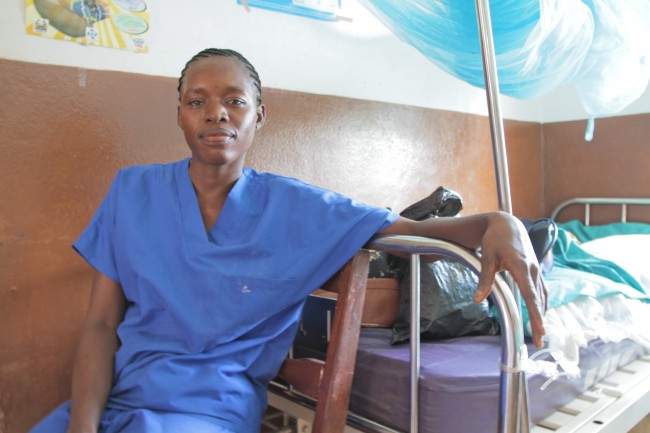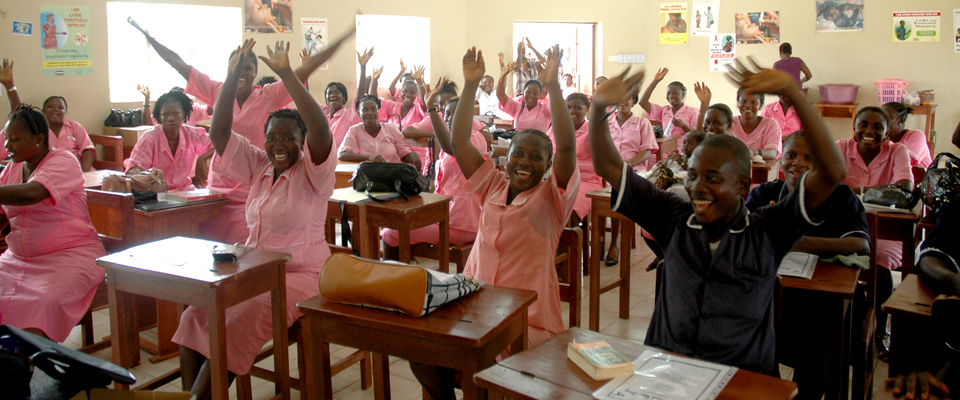
Interviews with Kambia Hospital staff as part of the IHLFS Evaluation Report (December 2012)
Fatmata J. Momodu – Midwife, Kambia Hospital Maternity Ward

I have been in post at Kambia District Hospital since August 2012. I attended the IHLFS training course in November 2012.
The training was educative. I came top in the neonatal resuscitation session. It was a refresher course to remind us of past training. There is no refresher training given in Kambia to midwives once they are qualified other than this Kambia Appeal training.
This training is needed because here in Sierra Leone the main problem is that women do not like to deliver at the hospital. They prefer to deliver at home, but things go wrong and they seek care too late. This then makes our job too difficult to save them. One woman has just arrived here at the maternity ward. She came to the hospital with a fever, but we found that she had a ruptured uterus. If she had come to us sooner it would have been easier for us to help her, and the outcome might have been more positive.
On the training course the UK trainers were easy to understand and the teaching was good. We were given handouts at the end of the training and there were practical learning sessions. We did pre and post training tests, and the scores increased after the teaching. My scores increased from 213 to 218, so I am very pleased. This was all refresher training, helping me to remember my basic training as a midwife. In the future, I would like a higher level course, because I always like to strive higher.
Fatamta J. Momodu reported two Patient Case Studies:-
Case Study: Mabinty Kamara – aged 38 years
The patient was referred from Kokuna Village PHU, 40 miles from Kambia and was admitted on 29 Nov 2012.
Mabinty attended Kokuna PHU because she was in pain and bleeding. The PHU nurse in-charge was absent, but the volunteer assistant called for the hospital ambulance and called the Kambia hospital to give a verbal referral. When she arrived here in Kambia, the hospital staff diagnosed APH, and treatment began. Then the pain reduced, so they suspected placenta previa. An ultrasound scan was done at the hospital that showed that Mabinty had Type 2 placenta previa and showed that there was a live baby. Staff in the maternity ward advised her to have bed rest and she was kept under close monitoring and observation.
At 33 weeks pregnant this mother is not yet at term (40 weeks). As this mother had APH she is at a high risk of PPH. This is her ninth pregnancy and she has had 8 previous pregnancies, with 6 of those children alive.
This shows the health system here is working well as there were no delays in her coming from the PHU to the hospital and the patient was lucky that the ambulance was available and that the ambulance had fuel and was working. The patient is now stable and the relatives have been informed and reassured. As the patient is 33 weeks pregnant she can leave the hospital and will be advised to come back to the hospital to deliver her baby. She will need a blood transfusion and the hospital will keep a litre of blood back for this.
Case study: Patient Journey 2 – Isatu Bangura – Aged 25 years
The patient was referred from Mapotolon Village, 42 miles from Kambia, on 1 December 2012
This patient has one child and this was her second pregnancy. She came into the hospital with a high fever. She went to the PHU because she was having difficulty breathing, and the PHU called for the hospital ambulance and she was brought to the hospital. The hospital did investigations and confirmed that she has malaria.
After 2 days at the hospital the patient went into labour and had a premature delivery. The baby weighed 1.8kg, because of the high fever caused by malaria, and died during the night on Monday 3 December. The baby died because we do not have a Special Care Baby Unit at the hospital. The patient should have gone to the PHU earlier. The patient did go to an antenatal clinic at the PHU, but the patient’s mother was then away from her village for 2 weeks and in this time the patient was at home with a high fever until her mother returned. It was only then that the mother took her daughter back to the PHU. We have prescribed the patient with a blood tonic and she is being treated for malaria and anaemia. This is a very sad case.
Suad Koroma – SECHN, Kambia Hospital Maternity Ward

I attended IHLFS course in November 2011. I learned how to resuscitate a baby, and I have used these skills since then to help newly delivered babies on the maternity ward.
On the course you have to pay attention. We learned the ABC method: check that the airway is clear, that the baby is breathing, and that circulation is good. You watch for the colour of the baby. If it is going well the baby turns pink. I learned that as soon as the woman delivers, you wipe the baby’s face; you clear the airway; you check for the pulse; you make sure that the baby cries to supply oxygen to the brain.
The training was useful to me. The trainers were easy to understand. I worked in a little group of six colleagues with the UK trainer, and this small group made it easier to understand. One week is enough for the length of the training; this is a good time. I would want to attend another course. I want to learn more.

